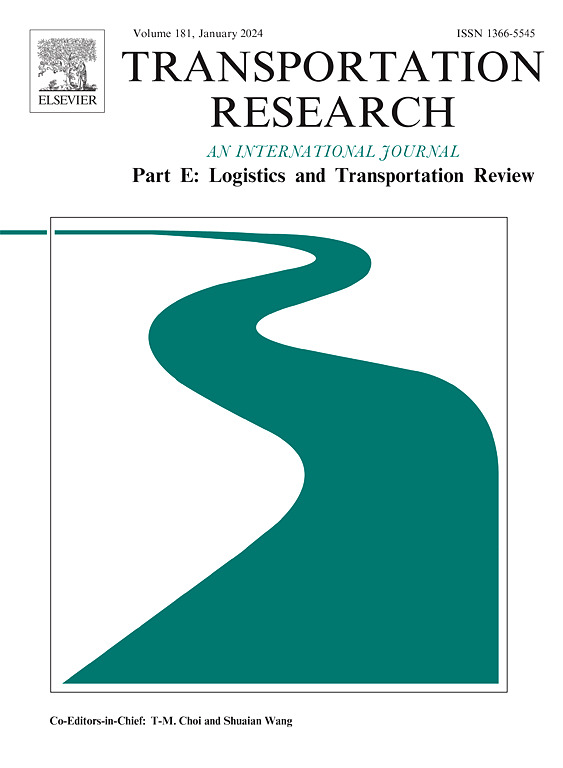智能仓库系统中多类型机器人的综合任务分配与路径规划
IF 8.3
1区 工程技术
Q1 ECONOMICS
Transportation Research Part E-Logistics and Transportation Review
Pub Date : 2025-02-01
DOI:10.1016/j.tre.2024.103883
引用次数: 0
摘要
本文研究了一种智能仓库系统(IWS),该系统需要三种类型的移动机器人:自动导引车(agv)、轨道导引车(rgv)和龙门起重设备(GLDs)的无缝协作。与agv组成的传统系统相比,IWS可以更灵活地满足不同企业的定制需求。针对多类型机器人(agv、rgv和gld)在IWS中的任务分配和路径规划问题,提出了一种集成的任务分配和路径规划问题。考虑了agv与gld、rgv与gld之间的合作约束,以及agv之间的无冲突约束。由于agv的无冲突约束会导致agv的任务完成时间不固定,并对agv、rgv和gld的任务分配带来计算挑战,因此解决agv无冲突约束下的多类型机器人调度问题具有挑战性。将多类型机器人的任务分配和路径规划集成问题建模为一种新的状态-时间-空间网络上的多商品流问题,并将其表述为整数线性规划(ILP)模型,其中仓库操作员的目标是最小化所有任务的总完成时间。我们开发了一种拉格朗日松弛启发式方法,使用定制的有效策略来寻找可行的解。我们还使用CPLEX对模型进行了求解。在某制造企业提供的仿真和实际实例上对定制拉格朗日松弛启发式算法进行了验证。结果表明,所提启发式算法优于基线算法。并对数值实验结果进行了敏感性分析,以帮助公司提高IWS的效率。本文章由计算机程序翻译,如有差异,请以英文原文为准。
Integrated task assignment and path planning for multi-type robots in an intelligent warehouse system
This paper considers an intelligent warehouse system (IWS) that requires the seamless cooperation of three types of mobile robots: automated guided vehicles (AGVs), rail-guided vehicles (RGVs), and gantry lifting devices (GLDs). Compared to the conventional system, which comprises AGVs, the IWS is more flexible in addressing with the customized demands of diverse enterprises. This paper proposes an integrated task assignment and path planning problem for multi-type robots (e.g., AGVs, RGVs, and GLDs) in IWS. The cooperative constraints between AGVs and GLDs, RGVs and GLDs, as well as the conflict-free constraints among AGVs, are considered. It is challenging to solve the multi-type robots scheduling problem with the conflict-free constraints of AGVs because these constraints can result in the unfixed task completion time of AGVs and pose computational challenges of the task assignment for AGVs, RGVs, and GLDs. The proposed integrated task assignment and path planning problem for multi-type robots is modeled as a multi-commodity flow problem on a novel state-time–space network and is formulated as an integer linear programming (ILP) model, where the warehouse operator aims to minimize the total completion time of all tasks. We developed a Lagrangian relaxation heuristic with a customized efficient strategy to find feasible solutions. We also solved our proposed model using CPLEX. The tailored Lagrangian relaxation heuristic was tested on simulated and real instances provided by a manufacturing company. The results show that the proposed heuristic outperforms the baseline algorithm. Sensitivity analyses from the numerical experiments are discussed, which can help the company improve the efficiency of the IWS.
求助全文
通过发布文献求助,成功后即可免费获取论文全文。
去求助
来源期刊
CiteScore
16.20
自引率
16.00%
发文量
285
审稿时长
62 days
期刊介绍:
Transportation Research Part E: Logistics and Transportation Review is a reputable journal that publishes high-quality articles covering a wide range of topics in the field of logistics and transportation research. The journal welcomes submissions on various subjects, including transport economics, transport infrastructure and investment appraisal, evaluation of public policies related to transportation, empirical and analytical studies of logistics management practices and performance, logistics and operations models, and logistics and supply chain management.
Part E aims to provide informative and well-researched articles that contribute to the understanding and advancement of the field. The content of the journal is complementary to other prestigious journals in transportation research, such as Transportation Research Part A: Policy and Practice, Part B: Methodological, Part C: Emerging Technologies, Part D: Transport and Environment, and Part F: Traffic Psychology and Behaviour. Together, these journals form a comprehensive and cohesive reference for current research in transportation science.

 求助内容:
求助内容: 应助结果提醒方式:
应助结果提醒方式:


